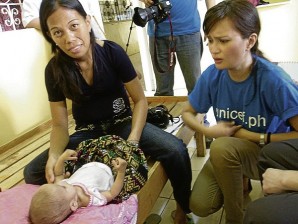It takes a village to fight hunger

TV PERSONALITY and Unicef special advocate for children Daphne Oseña Paez checks a malnourished child at Dinaig Municipal Hospital in Datu Odin Sinsuat, Maguindanao, where the United Nations agency is helping implement a community-based program to fight malnutrition among children caught in the crossfire of war between government and separatist Moro rebels. ROSA MAY DE GUZMAN/INQUIRER MINDANAO
Datu Odin Sinsuat, Maguindanao—Baidido Solaiman wore a wide smile inside a ward for malnourished children at Dinaig Municipal Hospital in Datu Odin Sinsuat town in Maguindanao. Her 7-month-old son Datu Ali looked in better shape now.
“My little Datu is gaining back gradually his lost weight,” the woman said.
Struck with pneumonia complicated by malnutrition, Datu Ali was admitted into the community-based management of acute malnutrition (CMAM), a community-led approach to combat malnutrition. The program was piloted in Maguindanao in 2009.
“I will not again lose a child from this dreaded disease,” Baidido, 28, said, recalling the death of another son from acute malnutrition.
Television personality and Unicef special advocate for children Daphne Oseña Paez, observed Datu Ali’s behavior with delight. “Look, he’s having a grand time chewing Plumpy’nut (peanut-based paste), and that manifests good health,” she said while stroking his tiny hands.
CMAM intervention
Following its experience in Africa, the United Nations Children’s Fund (Unicef) introduced the CMAM approach to rural health clinics and community-based hospitals in Maguindanao, and provided the equipment and funds needed to train their staff. The program relies heavily on ready-to-use therapeutic food (RUTF), a paste of high nutritional value which was developed for severely malnourished children and adults.
The CMAM program is Unicef’s primary program in combating malnutrition in the Philippines. Started in eight sites across Maguindanao since 2009, it finances a network of community outreach for patient care among children under 5 with severe acute malnutrition (SAM) and serious complications.
“They are treated at the community level with the RUTF and correct medications for the SAM and supplementary food provisions for moderate acute malnutrition (MAM),” said Dr. Paul Zambrano, Unicef nutrition officer.
In the management of the MAM, the World Food Program distributes ready-to-use supplementary food (RUSF) to children aged 6 to 59 months who are suffering from MAM and iron-fortified rice for pregnant and lactating mothers.
4 components
Zambrano said the CMAM had four “core” components—community outreach, out-patient therapy for SAM without complications, in-patient care in stabilization centers for SAM with complications, and management of MAM.
“The CMAM is the protocol that globally works for severe malnutrition, and this has been shown to reduce mortality by 5 percent,” he said.
Paez, a mother of three girls aged 8, 5 and 2 years, takes on the road her advocacy on breast-feeding and finding solution to malnutrition. She constantly reminds mothers of the importance of breast-feeding in the fight against malnutrition.
“Breast-feeding is one intervention that can really reduce malnutrition. Imagine it’s free and you will not buy anymore. It’s so easy. This is what I’ve been doing in the past two years—to encourage this culture,” she said.
The treatment for the severely malnourished is not just through intravenous line, which is the initial response of most medical professionals, she said. “When you go to the program, it’s a gradual remedy and you will see how the baby improves.”
Aghast at the aggressive advertising of milk formula companies, Paez encouraged mothers to exclusively breast-feed their babies from birth to 6 months.
Breast milk
“From the first hour, latch on right away. Just breast milk, no water, no supplement, no nothing, just the pureness of milk. People don’t realize that’s all the baby needs. And continue on until two years. This is all what babies really need. This eradicates potential infections. This is great, especially for the poor in the rural area,” Paez insisted.
“Breast-feed is so natural, it’s in your body. I had it in my body, and I gave it to my baby. The baby needs breast milk, no need to buy anything,” she added.
Looking squarely at the acute cases of malnutrition spread across Maguindanao, Paez thought of her daughters all born in peak condition.
“I’m just luckier, but there is so much hope with these babies because they are already responding, alert and asking for more food. These are really good signs. Yesterday, his (Datu Ali’s) eyes were sunken, he looks very weak. There’s hope that he is on his way to recovery,” she said.
“We really need help to reach out to more children,” she said of the stark images and stories that hit her. “Imagine over year-old babies that look like almost new born.”
National attention
“It’s very shocking and I’m very hopeful that there’s a program that works, and that’s already in place. Hopefully, the rest of the country will get to know about this. And brought up to the national level, that there will be a national policy for severe malnutrition,” Paez said.
As conflict in Central Mindanao remains deeply rooted, the struggle for health care lingers, according to Health Secretary Kadil Sinolinding of the Autonomous Region in Muslim Mindanao.
“It is our perennial problem. Expect it when there is unrest, when there is strife, when there is war, when there is chaos, there will always be malnourished children,” Sinolinding said.
He agreed that the CMAM had “perfectly” provided adequate nutrition to affected children and had doubtlessly solved the problem in its three years in the region.
“The first victims of displacement are the children. What kind of future will they have when we have this problem? I can’t take that the children are deprived of their most basic nutrition,” Sinolinding said.














